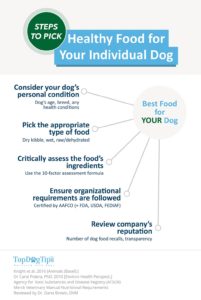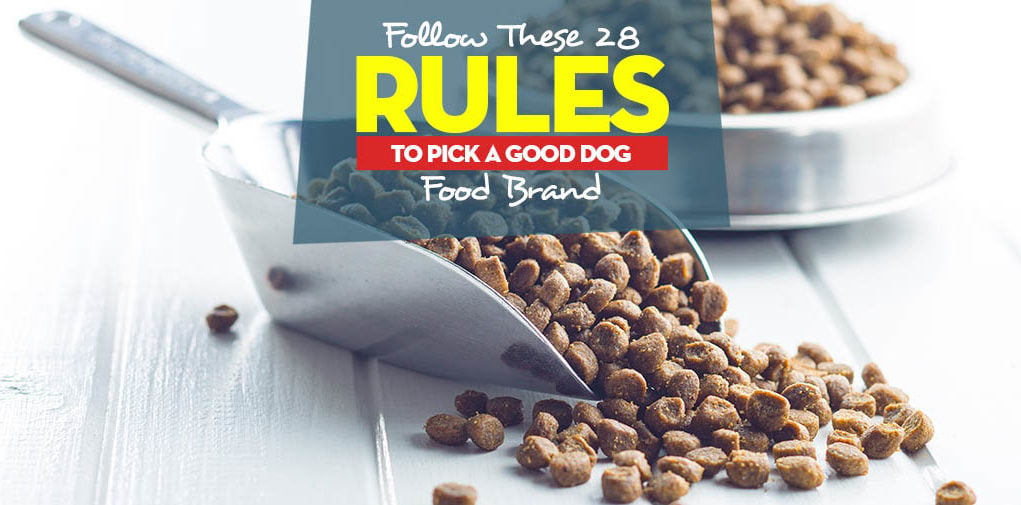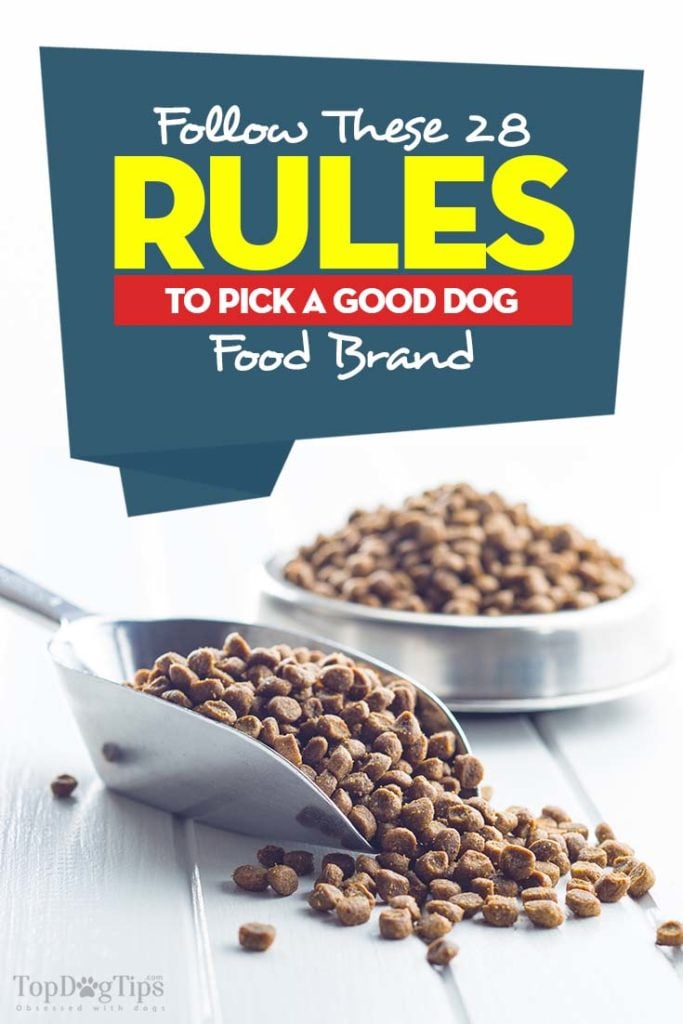There's a million and one articles out there packed with information on how to pick a good dog food brand. Unfortunately, the more information they provide, the more overwhelming these articles can be, and pet owners quickly get confused. This only makes choosing good dog food brands a more complicated process.
Table of Contents
- 28 Rules for Picking Good Dog Food Brands
- 1. Evaluate Your Dog
- 2. Look for Meat or Meat Meals
- 3. Avoid Animal By-products
- 4. Grain-free or Grain-full?
- 5. Types of Grains Matter
- 6. AAFCO Statement on Packaging
- 7. Research Good Dog Food Brands
- 8. Made in USA, Canada, EU
- 9. Sourcing of Ingredients
- 10. Small Breed Foods for Small Dogs
- 11. “Best Buy” Date of 6 months+
- 12. Named Protein Sources
- 13. Fresh Meat
- 14. Avoid Sugars and Sweeteners
- 15. Whole Ingredients
- 16. Avoid the “Artificial Three”
- 17. What’s in the Name
- 18. Feeding Trial Information
- 19. Supplementary Feeding Foods
- 20. Compare Pet Foods Fairly
- 21. Calorie Content
- 22. Variety in a Food Line
- 23. Grocery Store Foods
- 24. Useless Recommendations
- 25. Don’t Get Sucked in by Commercials
- 26. Too Good to Be True…
- 27. Forget Trends
- 28. Wording Can Be Deceiving
- Something to Keep in Mind
Complexities of Choosing Dog Food
When it comes to your dog's health, it's better to be proactive than reactive. The best way to keep your dog in tip top health is to feed him a diet that is completely balanced and meets all of his unique nutritional needs. But, with so much misinformation, fake claims and controversies surround the pet food industry, shopping for good dog food brands can be tricky and will turn into a frustrating task if you don't do the proper research.
 To begin your research for top food brand, your vet is the best resource. But, there are also other ways to evaluate a brand’s quality and whether it is appropriate for your pooch. You need to keep in mind that this isn't going to be a one-time thing. It’s something that you will need to do many times over the course of your pet’s life.
To begin your research for top food brand, your vet is the best resource. But, there are also other ways to evaluate a brand’s quality and whether it is appropriate for your pooch. You need to keep in mind that this isn't going to be a one-time thing. It’s something that you will need to do many times over the course of your pet’s life.
Studies show how you need to feed your dog based on his life stage. Puppies, senior dogs, active dogs, overweight/obese dogs and dogs with certain health conditions all have unique nutritional needs. There are other variables that come into play in determining the type of food you should feed your pet as well. For example, as your dog grows and develops, his nutritional requirements will need to change too.
Not all dog foods have the same quality, and even good dog food brands may not be what your Fido needs due to health concerns, his activity level, age or size. Every dog food company will do their best to make their meals sound healthy and nutritious, which is why it is so important for consumers to educate themselves and understand dog food labels properly.
Whenever you decide to switch your dog's diet, discuss the change with your veterinarian. They can evaluate your dog and help you choose good dog food brands that will meet your pet's needs and fit your budget.
28 Rules for Picking Good Dog Food Brands
 1. Evaluate Your Dog
1. Evaluate Your Dog
Construct a profile of your dog with their age, health, activity level, and allergies in mind. This profile will help you to narrow down good dog food brands to find one that suits your dog’s individual needs. Every dog is different, and there's no “one size fits all” foods.
2. Look for Meat or Meat Meals
Ingredients are listed according to weight and weight is affected by the water content. Even if dogs aren't carnivores, protein (preferably from animal-based source) is the most important macronutrient. Meat or meat meal should always be the first listed ingredient in a good quality food.
3. Avoid Animal By-products
Animal by-products are any parts of an animal that are not considered meat and have not been rendered. Although the AAFCO has strict governing standards over non-rendered animal by-products, many pet foods containing by-products are made with sub-par ingredients and should generally be avoided, even if not all of them are bad.
4. Grain-free or Grain-full?
Grain free foods should be considered a specialized diet, because not all dogs require or thrive on a grain-free diet. For some, grain-free can be dangerous. If your dog has shown no history of grain sensitivities, don’t shy away from grain containing foods. Different types of grains offer fiber content and health benefits that may be missing from grain-free foods.
5. Types of Grains Matter
If you are buying a food that isn’t grain-free, look for grains that offer better nutrition and longer lasting levels of energy. This is simply a matter of complex carbohydrates vs simple carbohydrates. For example, whole grains, oatmeal, brown rice, wild rice, fruits, and vegetables are all complex carbohydrates and beneficial as a dog food ingredient.
6. AAFCO Statement on Packaging
All dog foods must be labeled according to AAFCO standards. This label tells you what nutrition profiles the food is suited for. For example, a food approved for maintenance is fine for the average adult dog, however, a growing puppy would not receive adequate nutrition from this food. A puppy would require a food approved for all life stages including growth.
7. Research Good Dog Food Brands
With worrisome recalls always at the back of our minds, familiarize yourself with every one of the good dog food brands you are considering. Keep an eye on brands with recalls, and lean towards brands that have not had any. Some questions to consider include:
- Have they been a part of any recent recalls?
- Have they been part of a single recall or do they have a long history of recalls?
Don’t forget to take the lifespan of the company into consideration when considering their recall history.
8. Made in USA, Canada, EU
Choose pet foods that are made in United States, European Union or Canada to ensure better quality control than foods made in other, less regulated, countries. Beware that there are fake “Made in USA” dog food labels, and research the company for sourcing of ingredients.
9. Sourcing of Ingredients
Foods that are made in America, EU or Canada are not necessarily made with ingredients sourced from those countries. Look for pet food that have ingredients sourced in countries with a reputation for quality products. For example, lamb sourced from New Zealand. Ingredients sourced from disreputable countries may be tainted or of poorer quality.
10. Small Breed Foods for Small Dogs
Small breed dogs have different nutritional requirements and a prevalence towards different health conditions than large breed dogs. Select a small breed dog food brand for your small breed dog to provide them the best nutrition for their size. Likewise, look for formulas for large breed dogs when necessary.
11. “Best Buy” Date of 6 months+
Choose good dog food brands that don't contain artificial preservatives and that have a “Best Buy” date of at least 6 months away. The further away this date is, the fresher your food is and the lack of artificial preservatives means that your food is not being kept “fresh” through chemical processes.
12. Named Protein Sources
Whether you see “beef” or “beef meal” on the ingredients label, either way, you can be assured that your dog is eating beef. However, when the label refers to “meat meal”, there is no telling what type of meat you are feeding. Meat meals aren't always bad, but choosing dog food with named protein source is easier for a pet owner.
13. Fresh Meat
A dry dog food should feature “fresh” meat as a primary ingredient and a named protein meal source following that. This is desirable because dogs are opportunistic carnivores and because fresh meats contain only so much protein where named protein meal is a more concentrated source of protein.
14. Avoid Sugars and Sweeteners
Dogs have no need for sweeteners, yet many companies add them to their foods to entice dogs to eat them. Why? Because food made with poor quality ingredients have a poor flavor profile so adding sugars and sweeteners make them more palatable.
15. Whole Ingredients
Fruits and vegetables bring plenty of nutrients to the table, but these nutrients are compromised when only parts of the ingredients are used. Look for pet foods that incorporate whole ingredients like “tomatoes” rather than “tomato pomace.” Keep in mind that almost all foods will contain “parts” of ingredients, but they should also include more whole ingredients than “parts”.
16. Avoid the “Artificial Three”
Artificial colors, flavors, and preservatives are frequently included in big-name commercial pet foods. These chemicals add appeal to foods which may otherwise lack palatability or fail to attract consumers and extend their shelf life.
The artificial three have no nutritional value to your dog, however, and can bring with them a range of negative side effects as they build up over time. Look for foods that use natural preservatives, that do not have brightly colored kibble and do not use the word “flavor” on the ingredients list.
17. What’s in the Name
Governing regulations state that a pet food may only use certain names or phrases when describing their food if they meet specific criteria:
- A single ingredient food must contain 95% or more of that ingredient (water not included).
- A combination ingredient food must contain 95% or more of those ingredients (water not included).
- Foods that use the words “platter”, “dinner”, or “entrée” must contain 25% or more of the named ingredient.
- Foods that say “with” a named ingredient must contain 3% or more of the named ingredient.
- Foods advertised with named “flavors” need only contain a minute trace of that flavor.
18. Feeding Trial Information
Feeding trial information can be found on pet food bags and indicates that good dog food brands have been fed to living dogs during testing. These feeding trials establish that the food meets the nutritional standards for certain populations and is edible.
19. Supplementary Feeding Foods
If a food is labeled for supplementary feeding only that means that it is not nutritionally adequate for full-time feeding. If you are financially able to supplement this food with another food that is nutritionally sound, it’s perfectly fine to include it in your dog’s diet. Just don’t depend on supplementary foods for daily meals.
20. Compare Pet Foods Fairly
Because of the pet food industry regulations, the nutritional information on different foods is not always directly comparable due to different percentages of water content. To compare the nutrition of two foods fairly, compare their dry matter basis nutrition information which takes water content out of the equation.
21. Calorie Content
Two great dog food brands may contain the same amount of moisture, the same protein source, and the same recommendation for all life stage feeding, but that does not mean that they contain the same calorie content.
For example, a senior dog can eat an “all life stage” food formula, but their activity level is much lower than a young adult dog who eats the same food, so their caloric needs are lower. Now, you can feed both dogs the same food, but the more active dog needs more food than the senior dog. A good food choice for your dog should meet their caloric needs but do so in a way that is budget-friendly.
22. Variety in a Food Line
There's no clear consensus on this yet. Some claim dogs don't need variety while others argue that dogs that subsist on the same variety of food throughout their life are prone to allergies and sensitivities due to lack of exposure to various ingredients.
To be safe, it may be a good idea to look for pet food brands that offers various “recipes” that you can rotate through your dog’s feeding schedule to avoid these complications.
23. Grocery Store Foods
Grocery stores tend to stock more affordable foods from manufacturers that also produce human products (like Colgate and Mars). This is more convenient and profitable arrangement for stores, but the foods are commonly made with sub-par ingredients that are cheap to get hold of but offer poor quality nutrition.
Instead of grocery store dog foods, go for pet food companies that specialize in pet food production and who manufacture their own foods.
24. Useless Recommendations
This seems like a no-brainer, but you’d be surprised how many pet owners purchase foods because company representatives recommend it. These representatives are paid to sell their product and do not necessarily have veterinary experience. If you want a food recommendation talk to your vet or a veterinary nutritionist.
25. Don’t Get Sucked in by Commercials
Company A makes cheap dog food by using low-quality ingredients. They sell this food at a premium which means more profit for them. That profit can then be funneled into commercials and advertising campaigns that wow.
Does this mean that the food is good? Not at all. Instead of paying attention to commercials, when a food piques your interest do your research and compare the food to other recommended good dog food brands.
26. Too Good to Be True…
Dog food is a case of “you get what you pay for”, so you can’t expect to get top-of-the-line food for rock-bottom prices. For example, a dog food that costs $30 for 40 lbs. and whose representative tells you it’s a human-grade, organic, grain-free food is too good to be true.
The only exception to this rule is during “stock up” sales, with reward programs, during promotions and when coupons can be combined. Even then, however, premium foods will always cost more than budget foods.
27. Forget Trends
Some dog food companies promote foods as being “weight loss” formulas or “low fat dog food”, don’t fall prey to these advertising ploys. These phrases on the packaging result in a price markup but the truth is that you will find the same calorie count in regular brand name dog foods without the markup.
28. Wording Can Be Deceiving
Whether you’re looking at advertisements or product packaging, there are some phrases that companies use to increase sales, but that have no real meaning. Don’t get sucked in by these phrases and think that a dog food is something it’s not.
For example: “Scientifically formulated” does not mean that a dog food has benefits proven by science, rather it means that some type of scientific method was used to come up with the food formula. Did you know that the simple process of combining ingredients can be considered a scientific method?
Something to Keep in Mind
It won’t always be possible to find good dog food brands that meet all of the criteria noted above. If you find yourself in this situation, look at what each dog food brand offers, prioritize each one based on your dog’s individual needs and select the food that offers the most favorable profile.
The above 28 rules for picking good dog food brands is a simple guideline you can read a few times and keep these criteria in mind the next time you're shopping for your pet's food. Remember that all dog food companies lie to make profit, so always have your skeptic's hat on and use internet for research.
READ NEXT: Dog Food Prices – 30 Top Dog Food Brands & Their Value Compared














